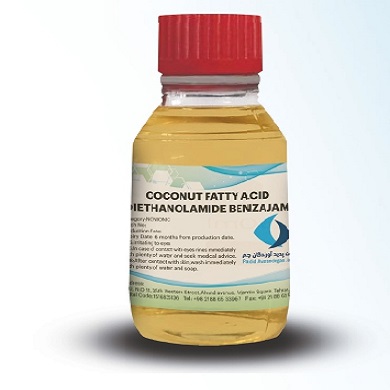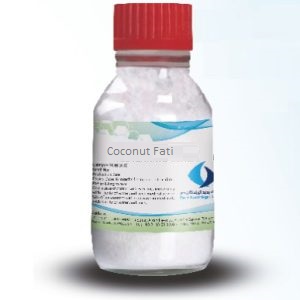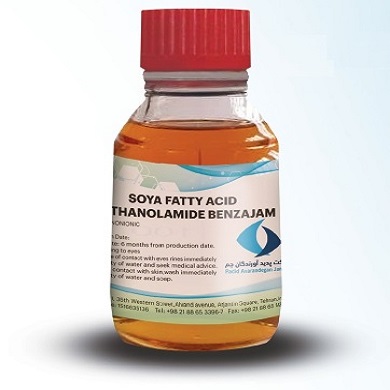coconut fatty acid diethanolamide
What is Cocamide DEA?
Cocamide DEA’s structure is a mixture of fatty acid diethanolamides constituting coconut oil. It comprises approximately 48.2% lauric acid, 18% myristic acid, 8.5% palmitic acid, 8% caprylic acid, 7% capric acid, 6% oleic acid, 2.3% stearic acid, and 2% linoleic acid. Cocamide DEA is a surfactant formed through chemical alteration of the chemical composition of certain fatty acids present in coconut oil with diethanolamine. The result of this chemical alteration is a viscous, amber-colored liquid used as a foaming and emulsifying agent in cosmetic, hygiene, and personal care products.
Description
Specification of Cocamide DEA
When storing and transporting Cocamide DEA, it is advisable to observe the usual precautions. It is recommended to use gloves and safety glasses when handling and transporting containers containing this chemical substance. Containers stored at temperatures below 49 degrees Celsius are the best option for storing this surfactant.
Like all amides, Cocamide DEA may form stearamide due to excessive heating. To reverse the reaction, the substance can be left at room temperature for one week. If the product’s formulation does not return to its original state, its thickening and emulsifying properties may decrease. For storing large volumes of the product, stainless steel or fiberglass tanks should be used. Additionally, all transfer lines and pumps that the product must pass through should be made of stainless steel 316 and have temperatures between 29 and 41 degrees Celsius.
Applications of Cocamide DEA
Cocamide DEA is commonly used in cosmetics, personal care products, and personal hygiene. This substance is used in the formulation of shampoos, hair dyes, bath products, and lotions. Cocamide DEA, similar to Lauramide DEA, Linoleamide DEA, and Oleamide DEA, is derived from fatty acids of various substances. These sticky liquids with high viscosity or waxy solids are derivatives of diethanolamine fatty acids (DEA).
Why is Cocamide DEA used in cosmetics, personal care, and personal hygiene products?
Cocamide DEA or Cocamide Diethanolamine increases the cleansing power of cosmetic and personal care products and stabilizes their lather. They are also used to thicken the liquid part of cosmetic and personal care products.
An analysis of 2354 registered cleaning and cleansing agents in the Danish product registry in 1992 revealed that products such as car wash products, detergents for washing textiles, dishwashing liquids, surface polishes, general cleaners, shampoos, strong cleaners, and skin cleansers contain Cocamide Diethanolamide.
Other properties of Cocamide DEA
Cocamide DEA and MEA (Monoethanolamine) are widely used to thicken the liquid phase of cosmetic products, maintain a mixture of ingredients, prevent the separation of different components of products, and enhance cleansing properties. These substances can be derived from coconut oil or synthesized artificially. It is worth mentioning that fatty acid diethanolamide, including coconut oil diethanolamine fluids, are widely used in cosmetic products. It has been reported that coconut oil ethanolamine fluids are present in nearly 600 formulations of cosmetic oils such as bath oils, shampoos, conditioners, lipsticks, and hair dyes. The concentration of diethanolamide in these products is between 1 to 25%. Non-cosmetic and hygiene uses of Cocamide Diethanolamide include its use as a surfactant in soap, light detergents, and dishwashing detergents, as well as a substance for removing lint from cotton seeds. Coconut oil diethanolamine fluids are also used as corrosion inhibitors in water-based metalworking and coating solutions. They are also widely used as antistatic agents in plastics, such as in polyethylene films for food packaging and rigid polyvinyl chloride. This substance is used in combination with metallic salts as an antistatic agent for polystyrene and in impact-resistant styrene butadiene rubber compounds.
Biological degradation of Cocamide DEA
Alkanolamides were discovered in 1937, and their use in various products was gradually discovered. In 1950, their use as detergents, shampoos, and cleansing products began, and due to their unique properties and characteristics, their use gradually expanded. Academic research indicates that ethoxylated and non-ethoxylated alkanolamides are completely biodegradable. Therefore, Cocamide DEA can also be considered as a biodegradable chemical substance. The initial degradation of 100% of this product occurs within 3 hours to 3 days in the environment, and its complete degradation reaches about 93% within 15 days.
Hazards of Cocamide DEA in cosmetic products
Cocamide DEA and MEA have been thoroughly evaluated for safety, and their use in cosmetic products up to a concentration of 10% is allowed and poses no risk. Individuals exposed to Cocamide Diethanolamide in cosmetic formulations such as bath oils, shampoos, conditioners, lipsticks, hair dyes, soaps, light detergents, and dishwashing detergents are not at risk as long as the concentration is not high. However, Cocamide DEA can react with other compounds and form known harmful substances called nitrosamines.
According to the Cosmetic Ingredient Review (CIR), “To prevent the formation of potentially harmful nitrosamines, these substances should not be used in cosmetics and personal care products containing nitrosating agents.” The CIR Expert Panel concluded that “Cocamide DEA is safe in cleansing products and is safe at concentrations of less than 10% in products that remain on the skin for long periods.” A legal agreement between some shampoo manufacturers, lotions, and other personal care product manufacturers has been reached to eliminate Cocamide DEA from their products. However, the use of this chemical substance is not prohibited, and more than 100 other companies still use it in the production of cosmetics and personal care products.
Is the use of Cocamide Diethanolamide in cosmetic and personal care products dangerous?
The International Agency for Research on Cancer (IARC) has classified Cocamide DEA (coconut oil diethanolamine fluids) as a Group 2B carcinogen. IARC researchers wrote in a report: “There is sufficient evidence in laboratory animals for the carcinogenicity of coconut oil diethanolamine fluids.” Various IARC studies have different results, and no studies have been conducted on humans yet. Among the results of studies on mice, effects such as increased adenomas of liver cells, carcinoma of liver cells or hepatoblastoma, tubular adenoma of the kidney, or cancer have been observed, but such effects are not seen, for example, in desert mice.
Due to different opinions on the safety of Cocamide Diethanolamide, so far, 26 cosmetic and personal care product manufacturers have agreed not to use this chemical substance in their products. In 2012, California identified Cocamide DEA as a carcinogenic substance and required manufacturers to either put warnings on product labels or remove it from their products.
Market Sales and Application of Cocamide DEA
Cocamide DEA has a special sale in 200-kilogram barrels. Given that the annual consumption of this fatty acid in Iran has exceeded 3000 tons, the manufacturers have tried to maintain a stable price for Cocamide DEA by increasing production and preserving quality. The Cocamide DEA produced by Jom Pidarandegan Company is completely suitable for use in the detergent and textile industries and currently has many applications in the production of various shampoos, dishwashing liquids, cleaners, and surface cleaners.
Some of the practical properties of this substance include:
– Cleaning properties that result in high-speed and high-quality surface cleaning.
– High viscosity, which is economically advantageous for product sales.
– Strengthening properties to create foam and control it to prevent excessive foaming, which is ideal for producing various detergents.
– Moisture control and removal of various fats and oils from surfaces, turning this product into an exceptional detergent.
– Softening and conditioning of hair, which is enhanced in shampoos using it.
Some of the main uses of this substance include:
– Various household and industrial detergents
– Car wash
– Thick surface cleaners
– Ready-to-use cleaners
– Kitchen surface cleaners
– Fabric moisturizing process in textiles
– Waterless hand cleaners





